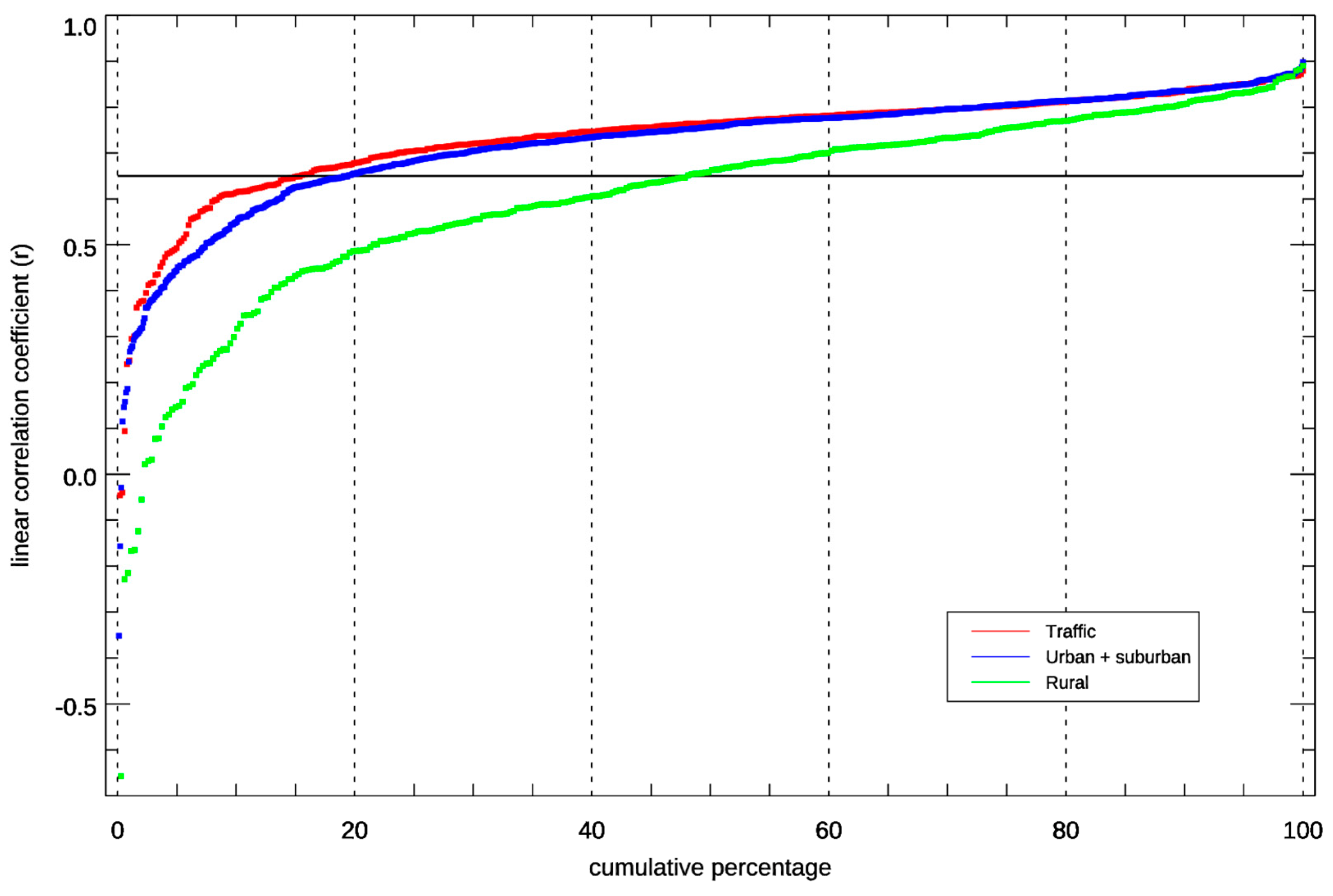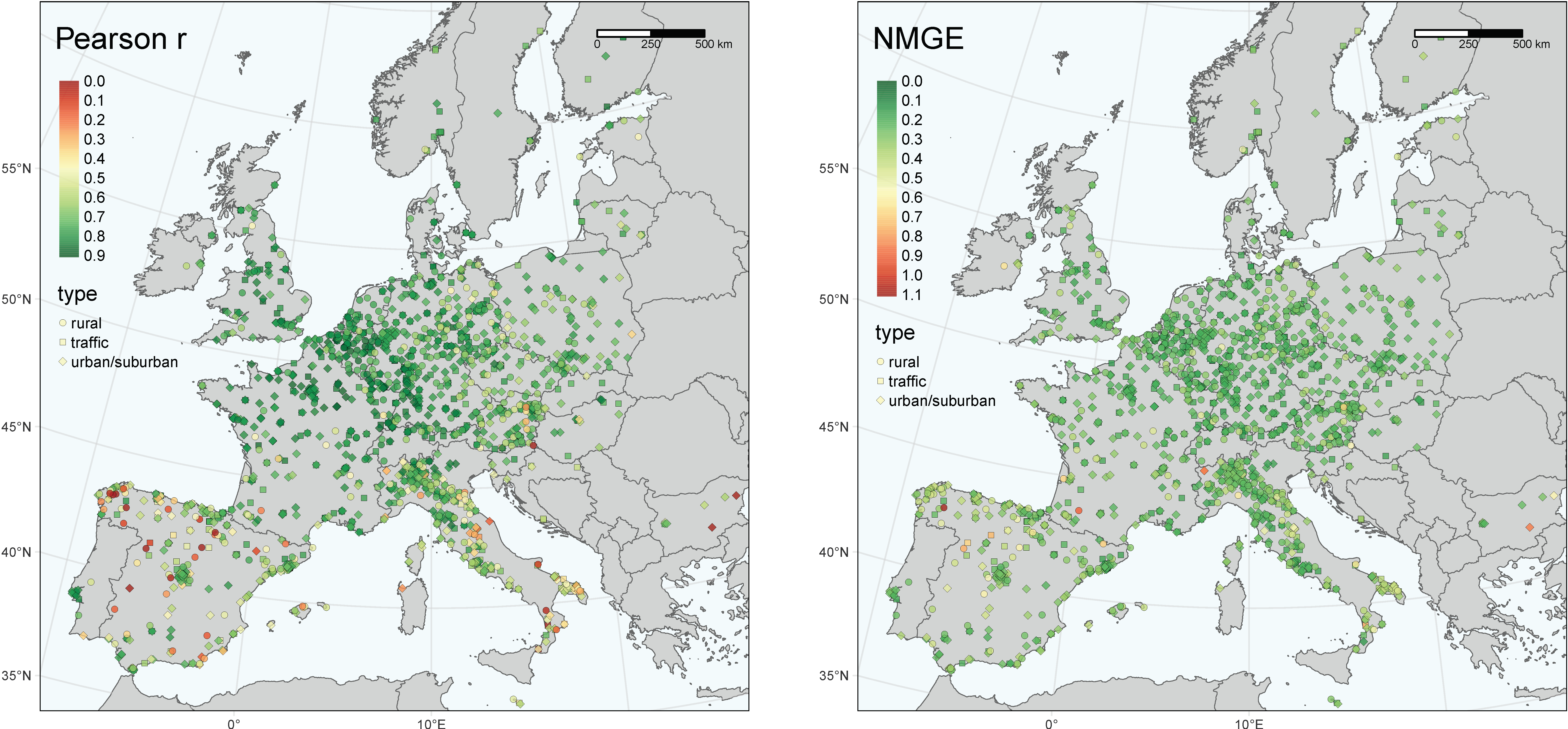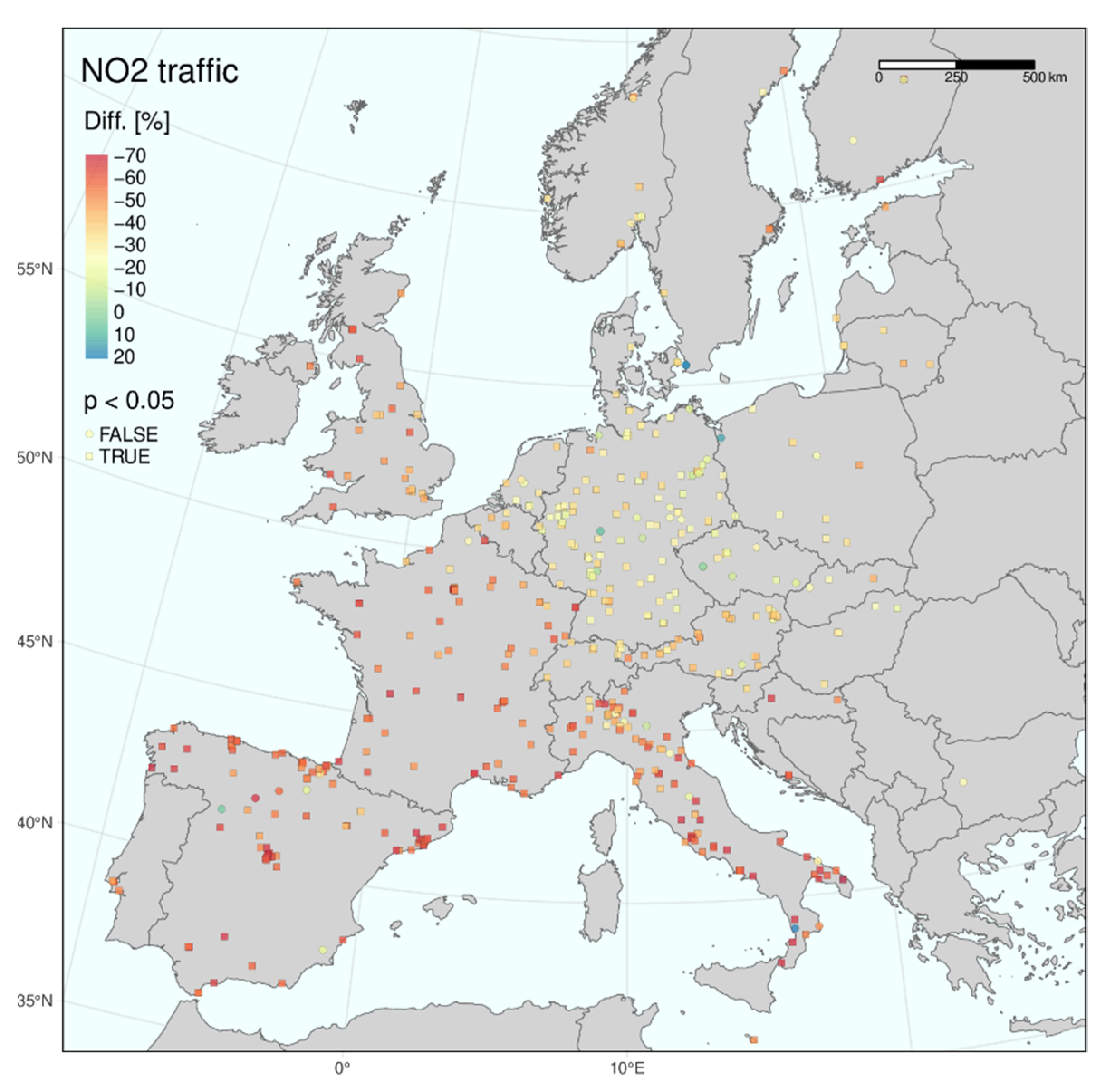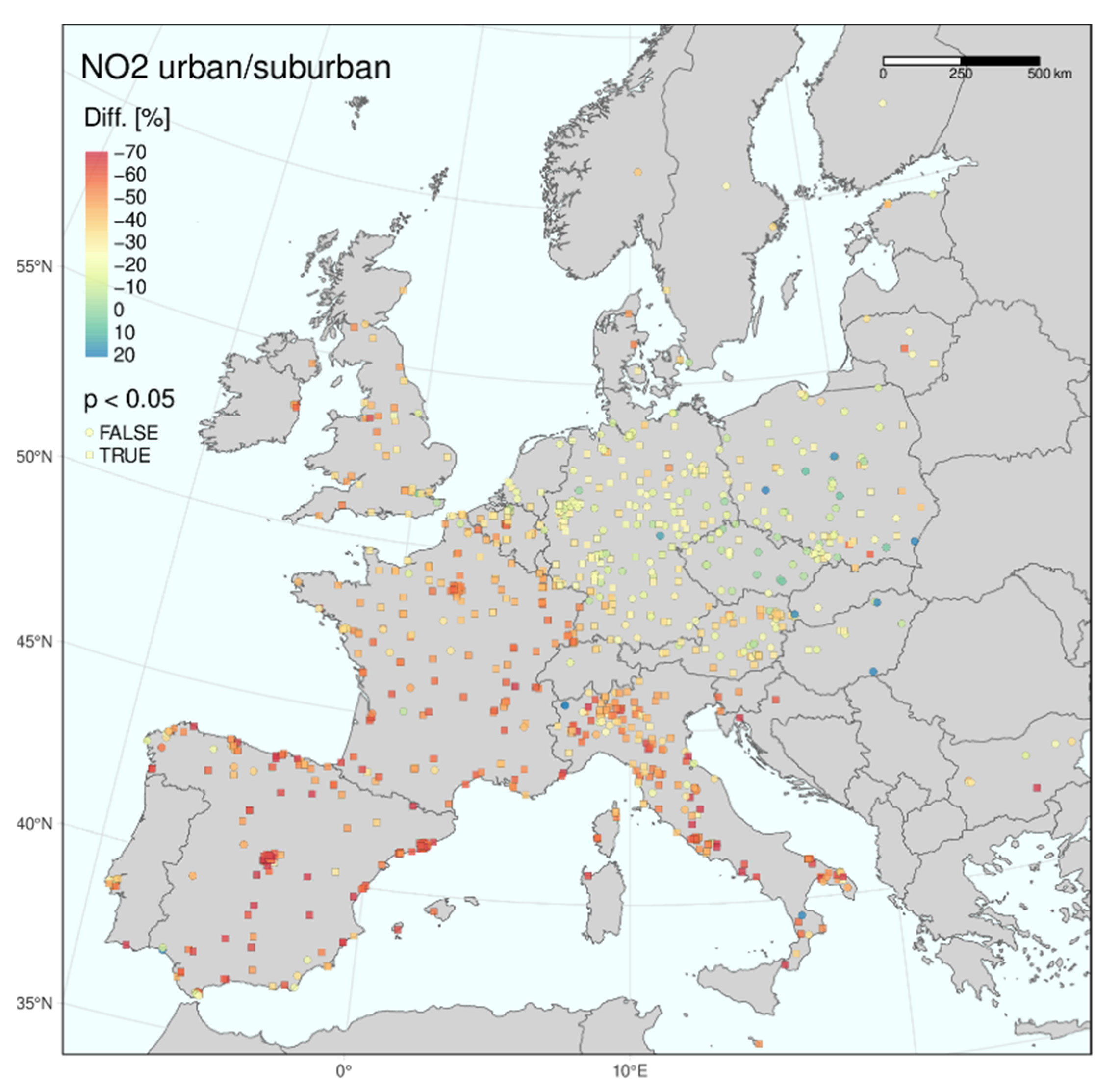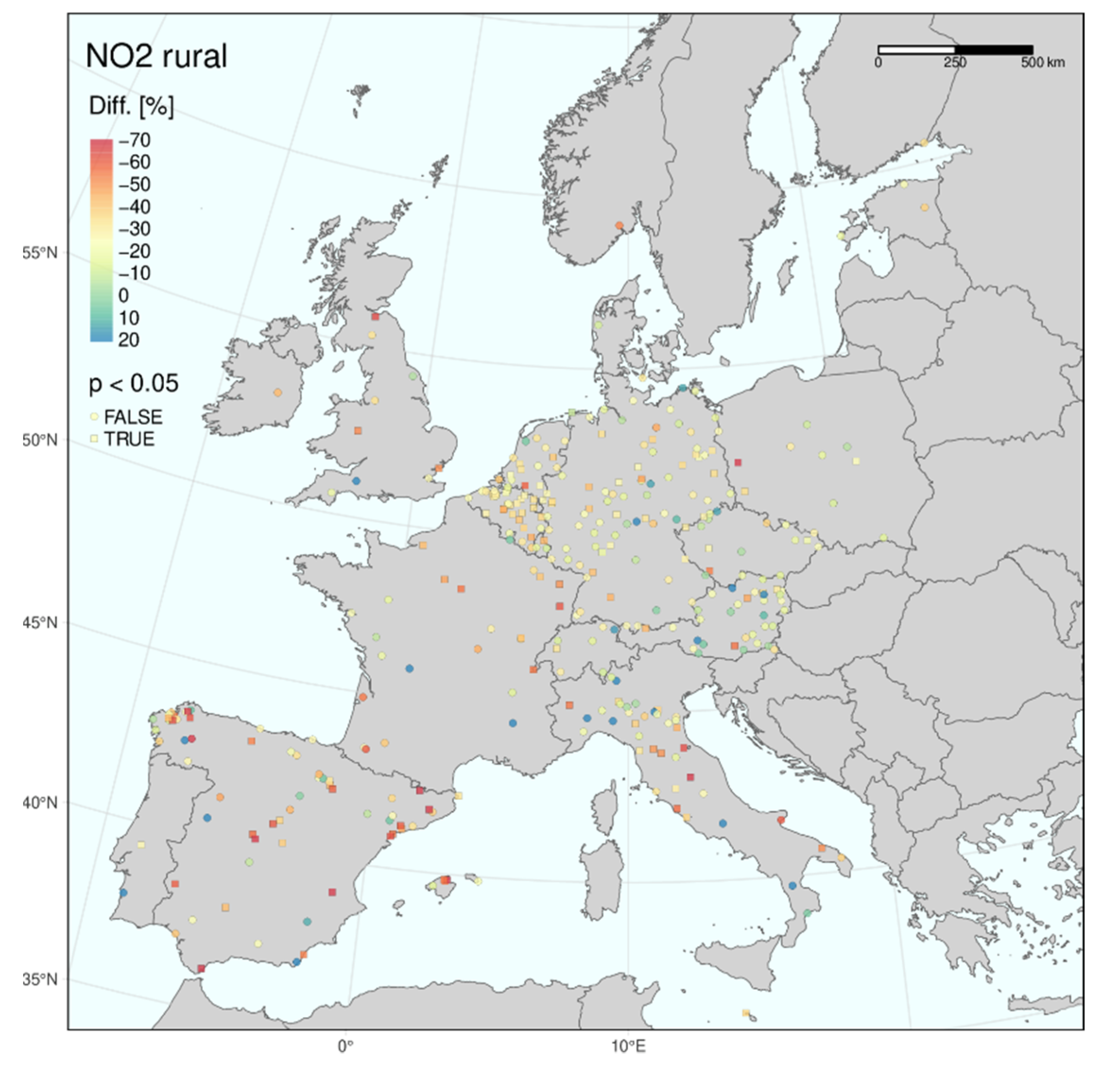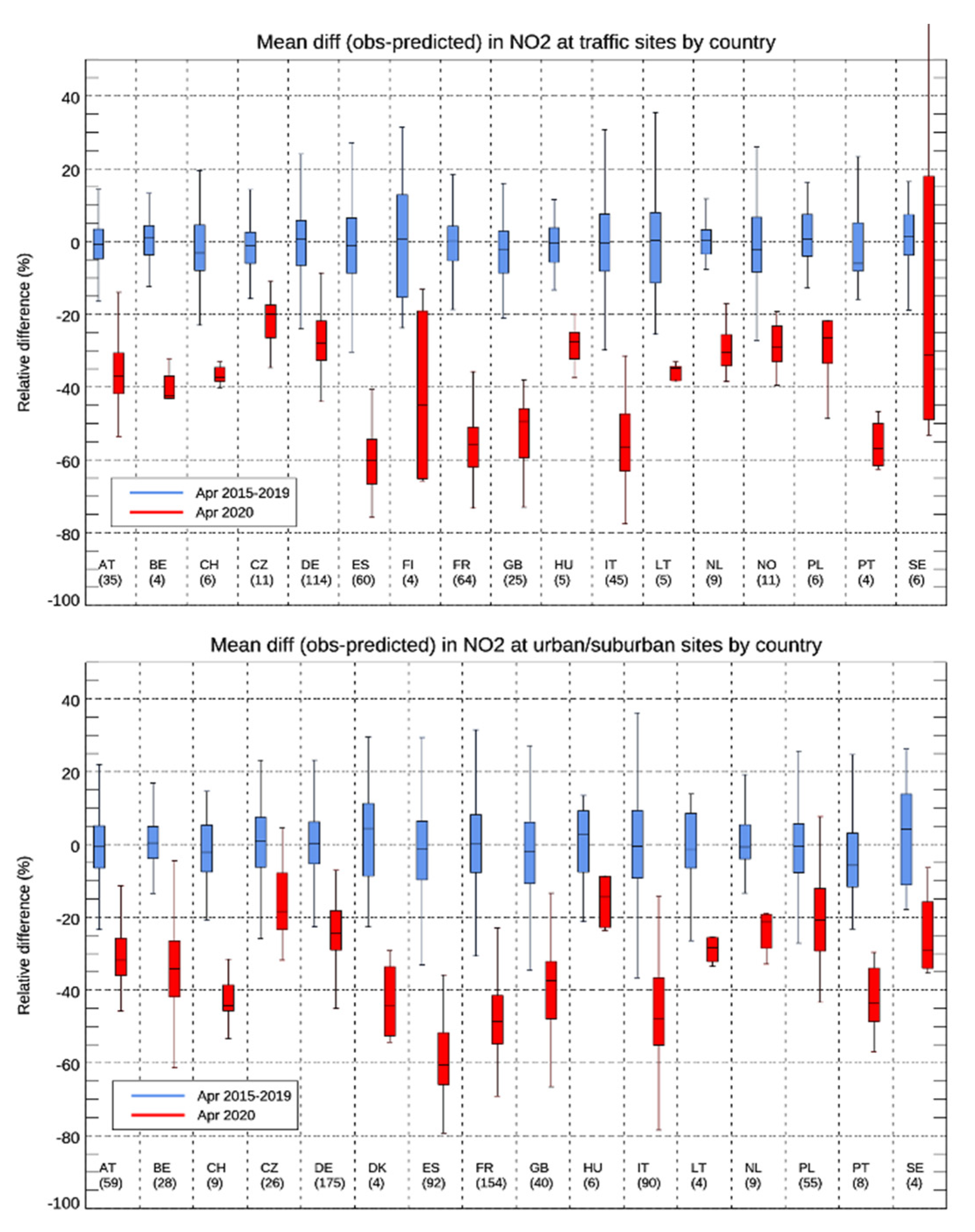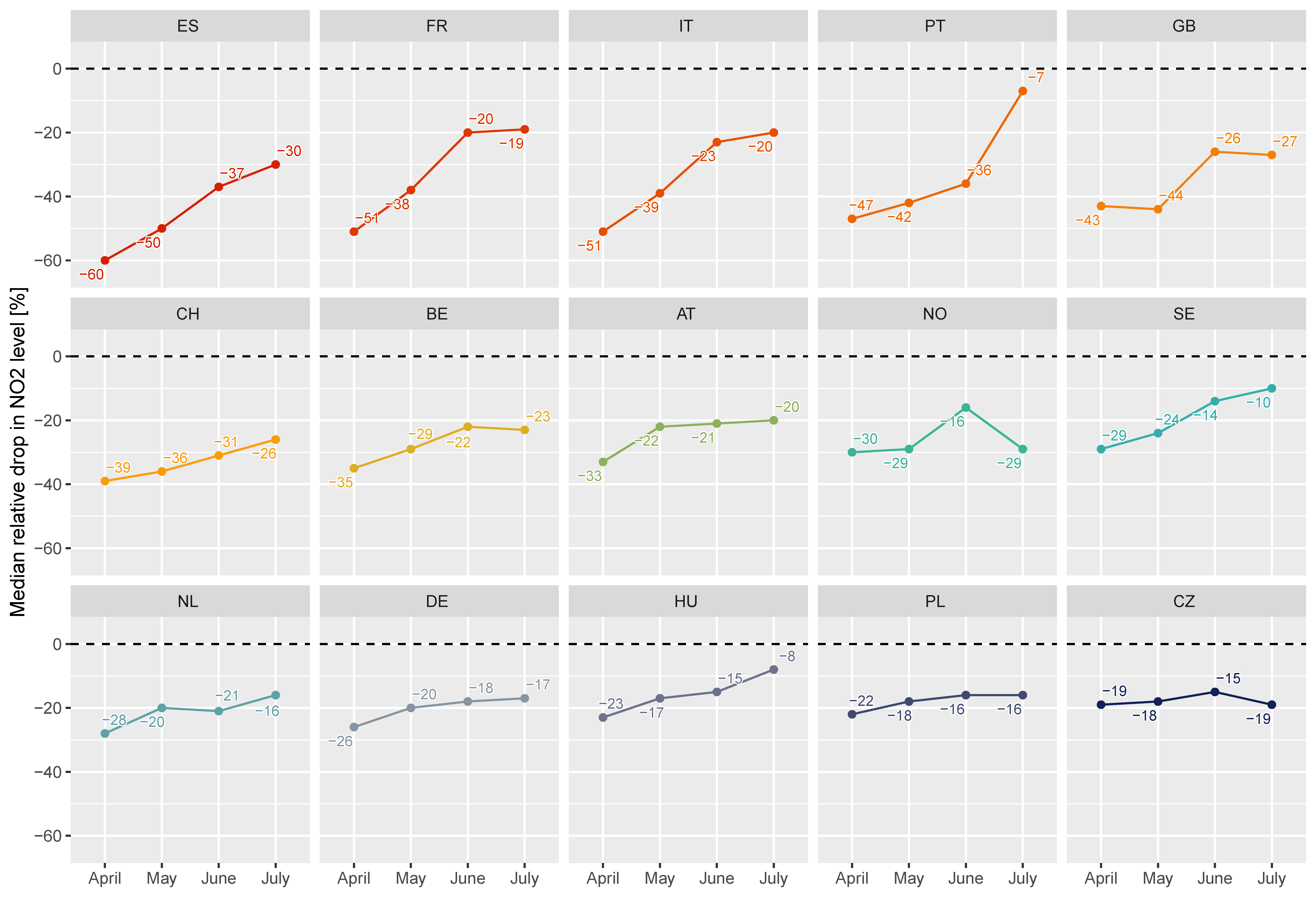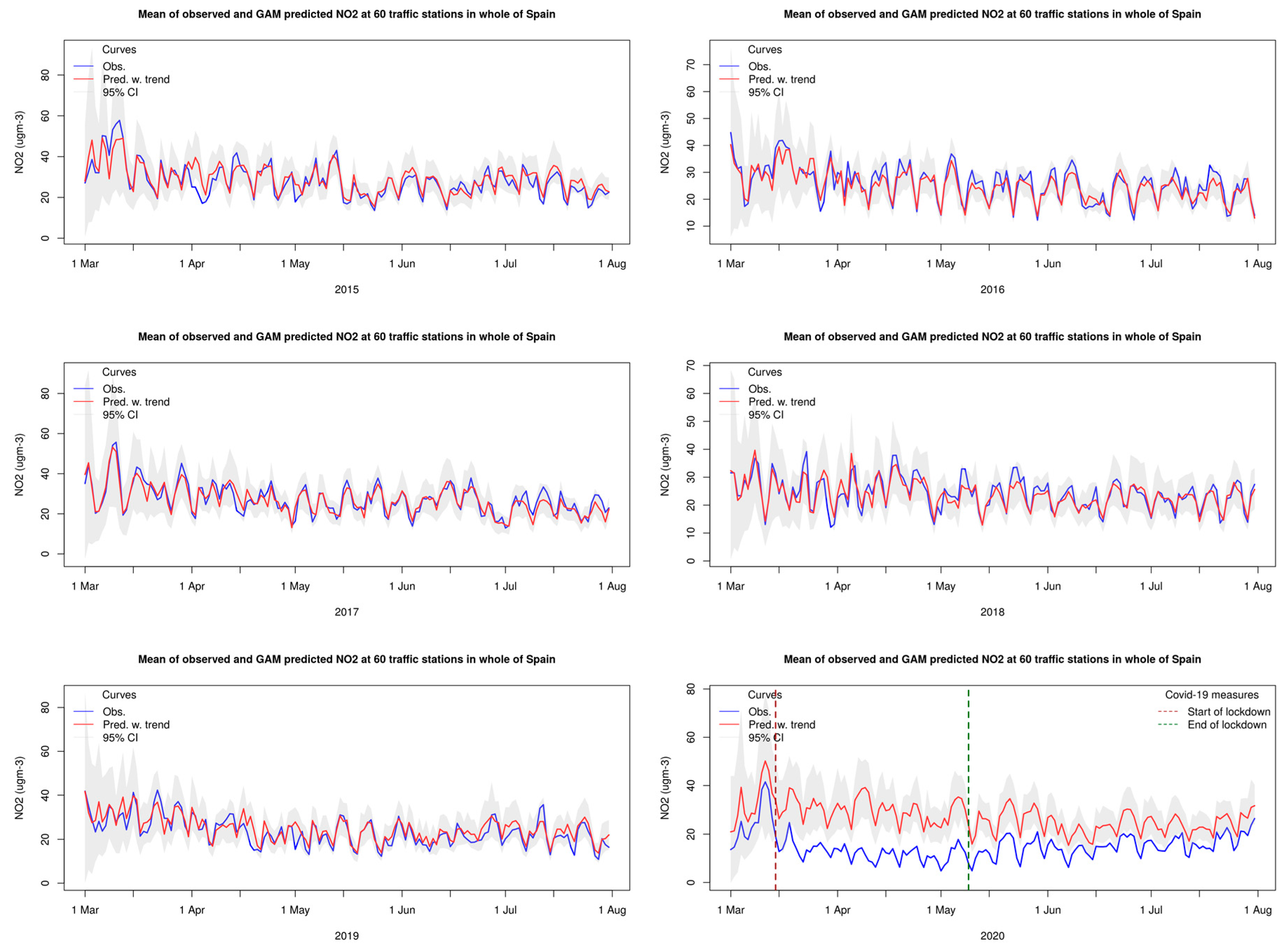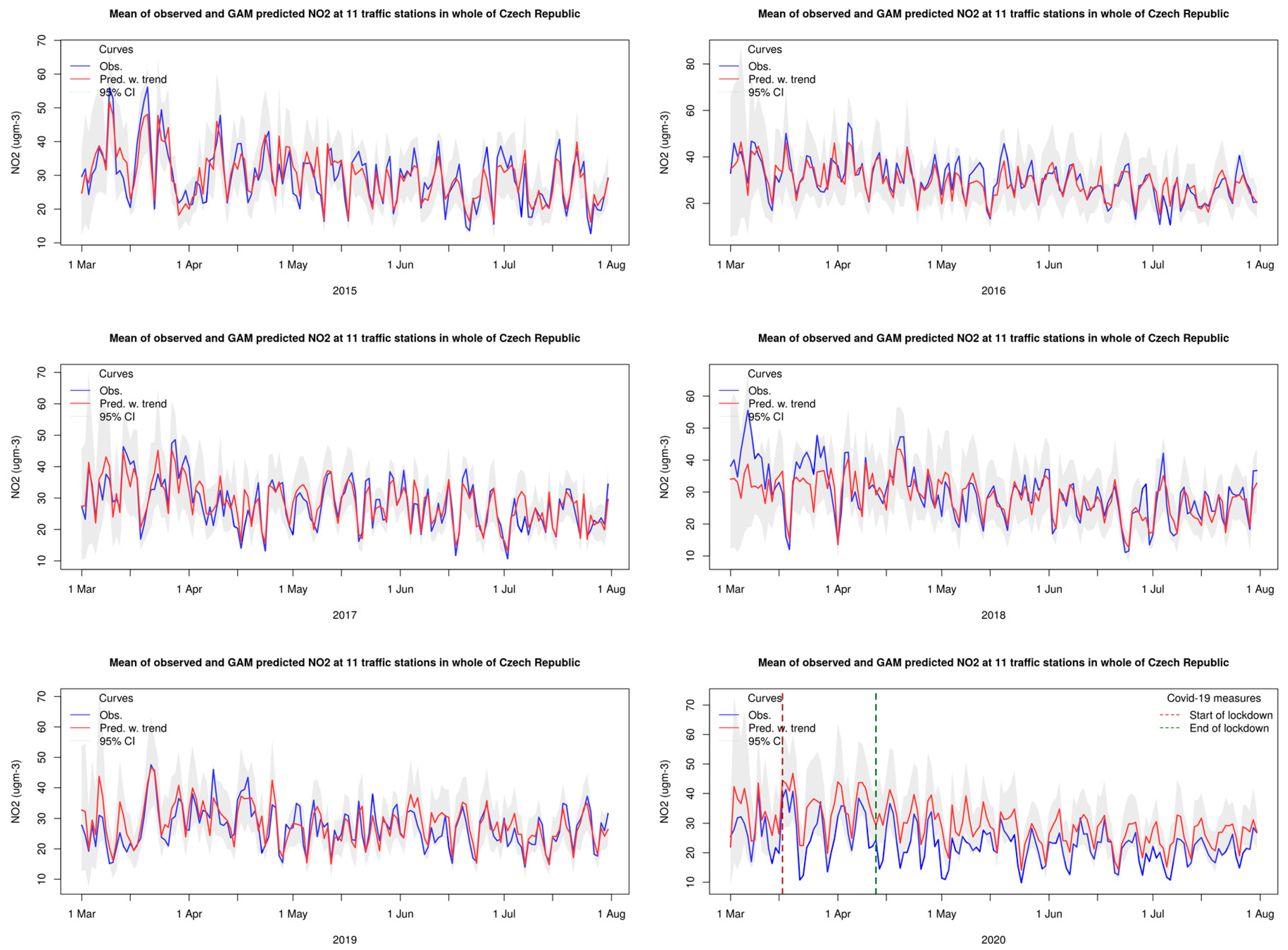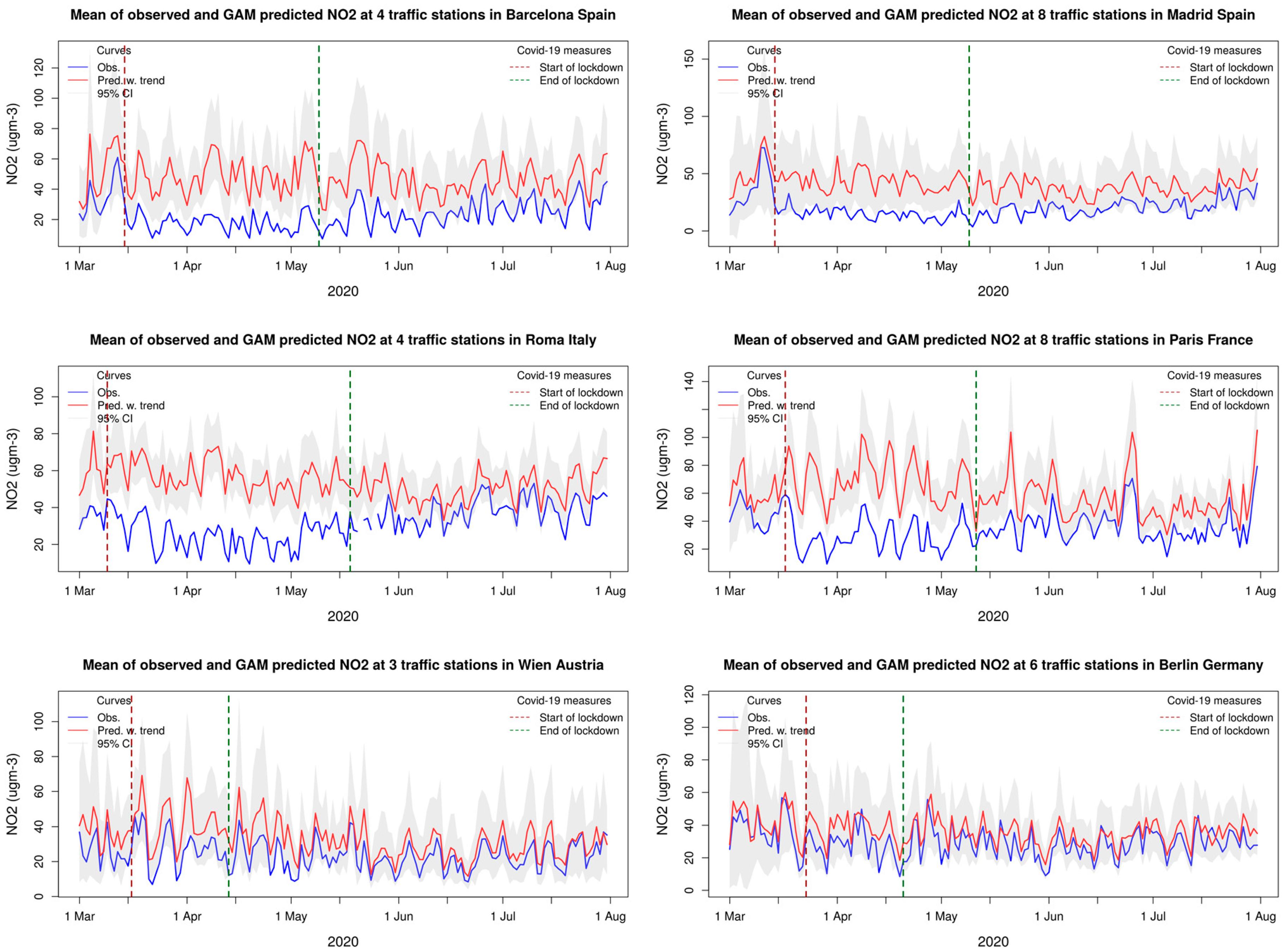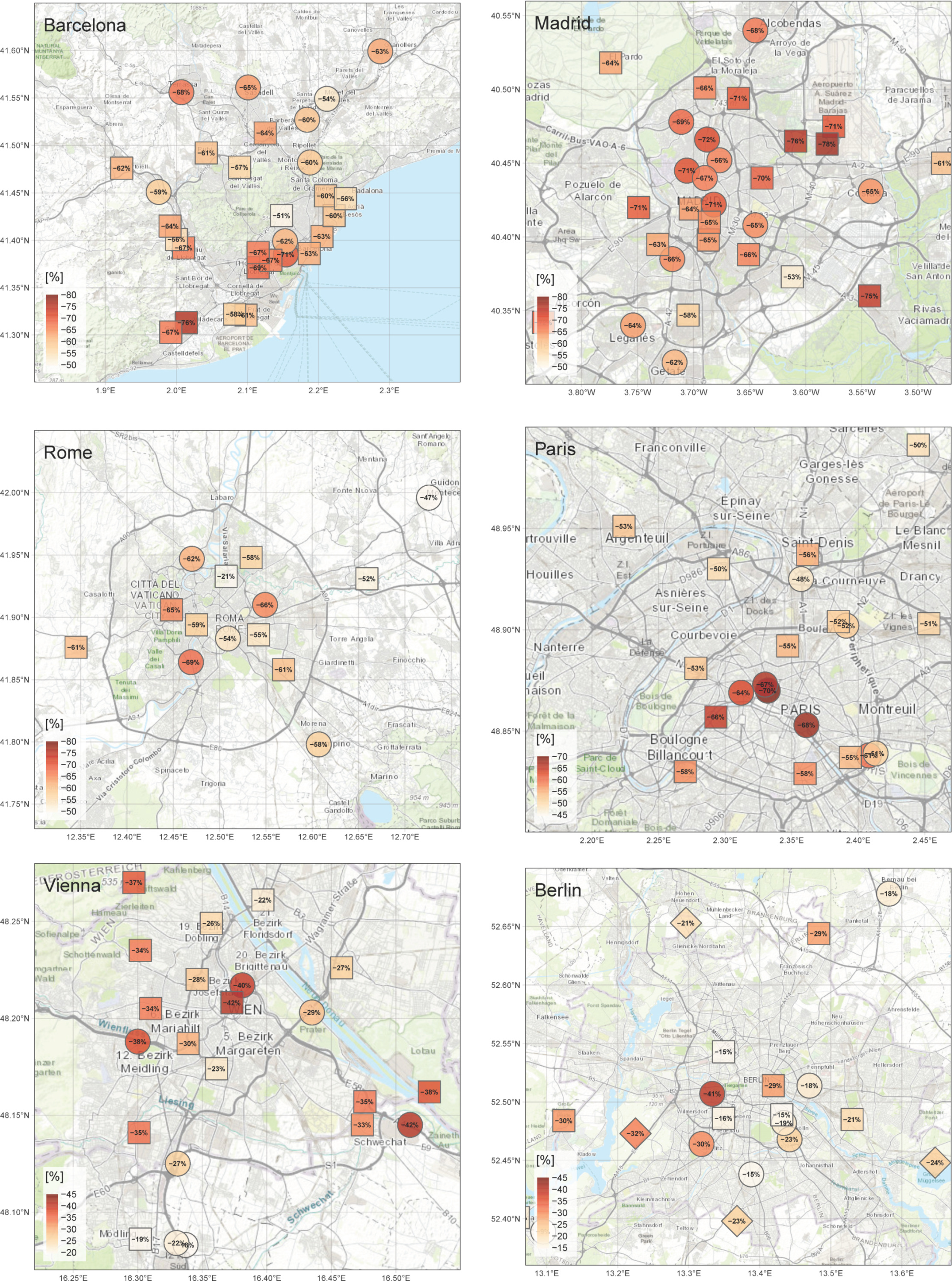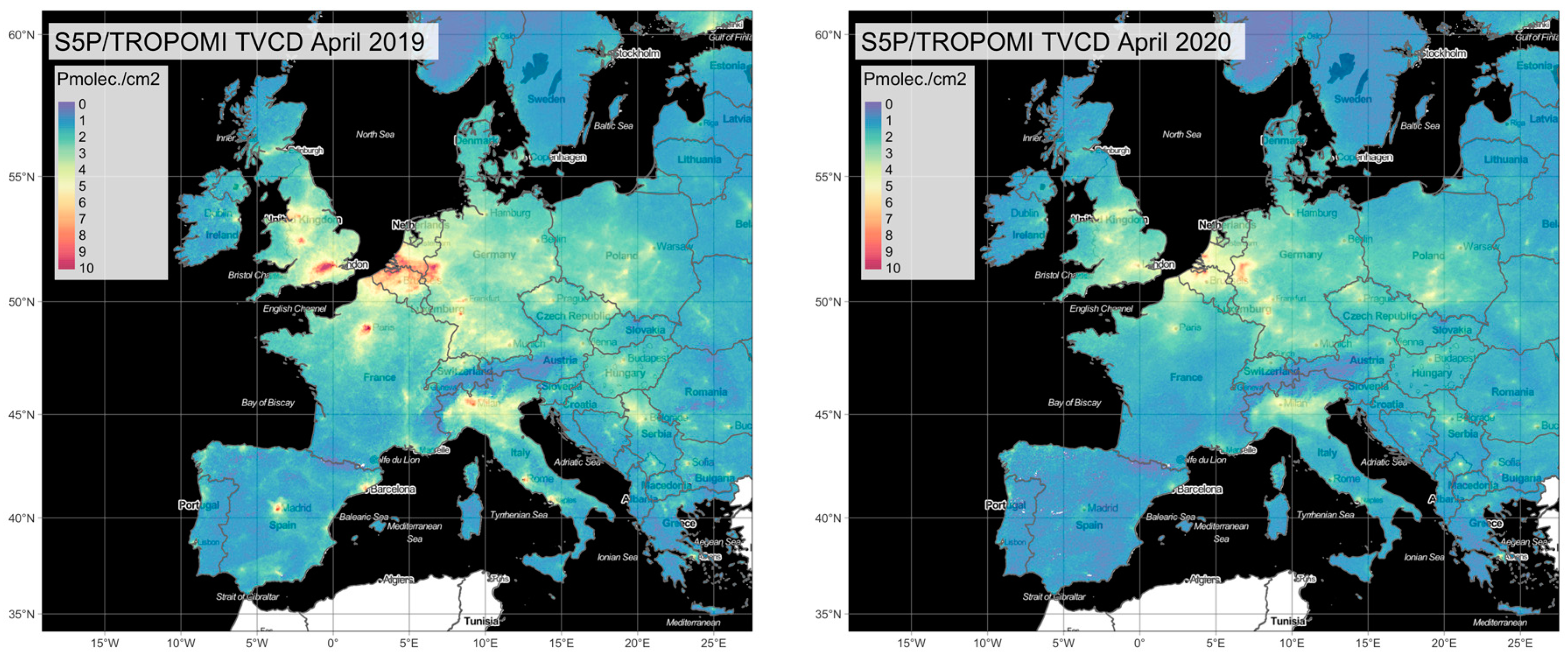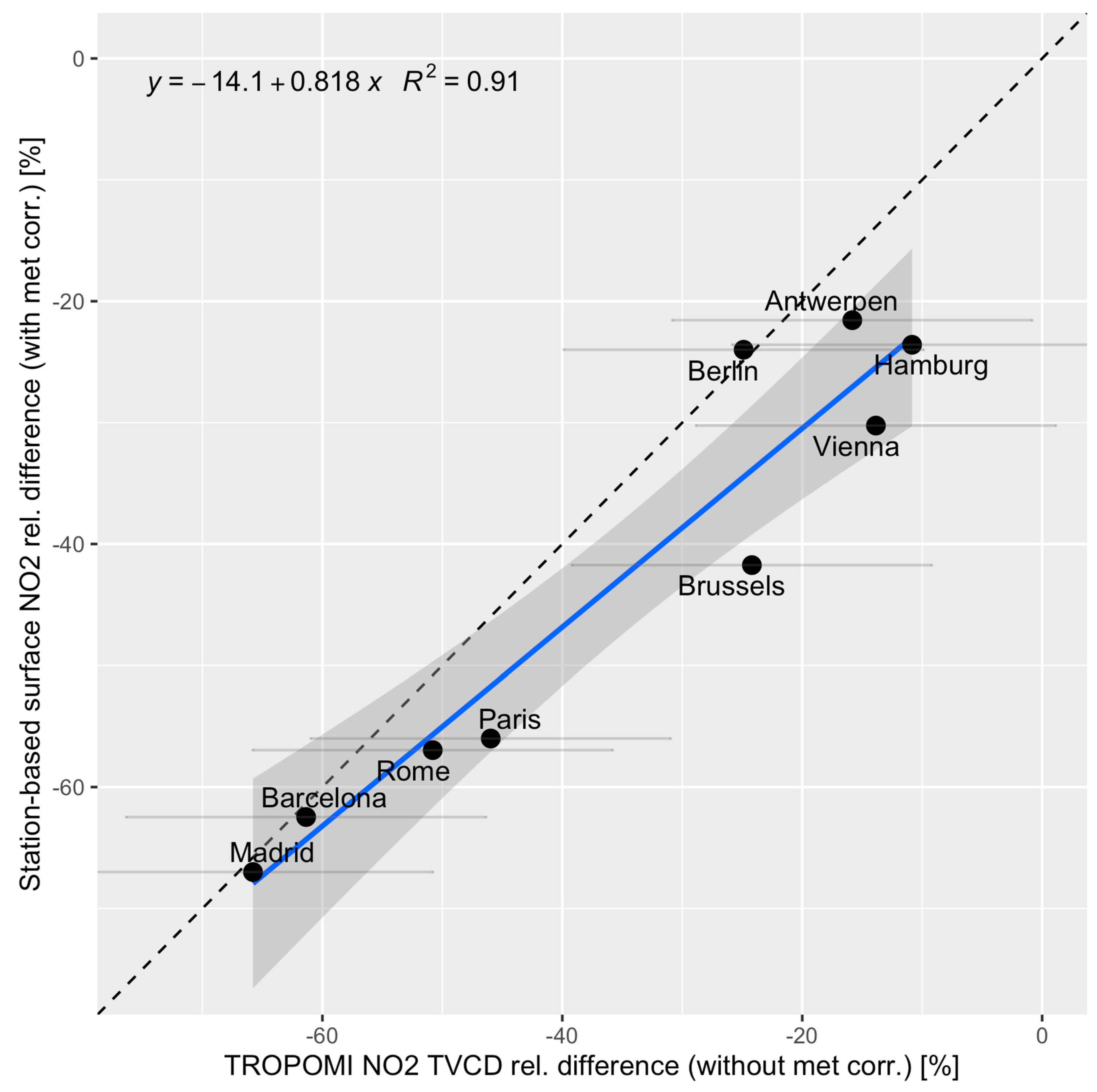1. Introduction
The global Covid-19 pandemic in 2020 has led to major changes in society, the economy, and transportation worldwide. In Europe, the first cases of Covid-19 were detected by the end of January. In February, the number of incidents increased substantially in a few countries—Italy, France and Spain—and Italy was the first country in Europe to introduce restrictions on the population. Italy imposed a quarantine on more than 50,000 people in the northern part of the country on 22 February.
During March, most European countries introduced a full national lockdown, and most of these actions were taken mid-month. By 18 March, more than 250 million people were in lockdown in Europe, and by the beginning of April, 3.9 billion people or around half the global population were subject to complete or partial lockdown [
1]. The global road transport activity was almost 50% below the 2019 average by the end of March, and commercial flight activity nearly 75% below 2019 by mid-April 2020 [
2]. The lockdown restrictions were gradually lifted in the following weeks and months, varying substantially between the countries in Europe.
The reduced road transport and aviation led to reduced emissions of air pollutants and thereby lower levels of atmospheric pollutants, as documented by several European studies [
3,
4,
5,
6,
7,
8,
9,
10,
11]. The quantification of this effect is, however, not trivial. First, weather patterns have a decisive influence on air pollutants’ concentration through atmospheric mixing and wash-out of aerosols by precipitation. Dacre et al. [
5] showed that meteorology changes from pre- to post-lockdown periods in the UK counteracted the effect of reduced NO
x emissions. Second, the onset of the lockdown was in spring, which typically is a transition period associated with marked changes in the prevailing pollutant levels. Peak levels of primary pollutants, such as NO
2, are typically observed in winter during episodes of low temperatures and inefficient atmospheric mixing. In contrast, secondary pollutants, such as O
3 and organic aerosols, peak in summer. Finally, an assessment of the lockdown effect on the pollutant levels should also consider the year-by-year downward trend in pollutants due to policy-driven emission abatement actions in Europe.
Several hundred journal articles have already been published on the link between the Covid-19 lockdown and reduced air pollution in Europe and other regions. The publications can be divided into three categories:
Pure observational-based studies in which the lockdown periods are compared with non-lockdown periods [
3,
10,
12], either using measurements from previous years or by looking at pre- and post-lockdown periods in 2020.
Studies based on chemical transport models (CTMs) and observations in combination [
4,
7,
8,
13,
14,
15,
16,
17] either by running separate baseline and lockdown emission scenarios or by estimating the lockdown effect from a comparison between measurements and business-as-usual scenarios.
Statistical based studies [
5,
6,
9,
18] using multiple regression, generalised additive model (GAM), or machine learning (ML) models to estimate the links between measured concentration levels and meteorological as well as time (day of week, etc.) data. Some studies also use a combination of statistical methods and CTMs [
4,
7].
There are pros and cons to each of these approaches. Pure observational-based studies are easy to conduct and avoid all model assumptions but are hampered by difficulties in subtracting the meteorological impact. CTM based studies are the standard way of assessing air pollution levels, but for the lockdown period, the CTMs were faced with difficulties with the emission scenarios since the emission changes during lockdown will vary with city, country and time. Some CTM studies use activity data during the lockdown as a proxy for the emissions [
8]. In contrast, others use country- and sector-resolved emission reduction factors [
4], and some studies have even turned off emissions from specific sectors entirely [
16].
An advantage of statistical models (compared to CTMs) is that they do not require any emissions assumptions. Furthermore, as opposed to CTMs, statistical models can be trained on data for each measurement station separately to give optimal prediction accuracy for every station. This is particularly important for, e.g., traffic sites since concentration levels at such locations can deviate quite substantially from the surrounding grid concentrations. The main disadvantage of statistical models vs. a CTM is that the former is not built as a physical causal model but only uses statistically found associations between a set of explanatory meteorological and time variables and the resulting concentrations. Thus, one should be careful with extrapolating results from such a model to other sites and periods far into the past or future.
In this paper, we show that a specific type of statistical regression model, namely a generalised additive model (GAM), is particularly well suited for isolating the effect of the reduced emissions from other confounding processes. Various studies using machine-learning (ML) methods have been used to assess the lockdown effect on air pollutants, and the gradient boosting technique has been particularly popular [
4,
7,
9]. The GAM approach [
19,
20] can also be considered an ML method. Still, the main advantage of a GAM model lies in its interpretability. It provides direct functional relationships between each input explanatory variable and the response variable (the atmospheric concentration). In contrast, other ML methods are less interpretable and tend to produce more “black-box” non-transparent relationships and results. The GAM modelling approach is also often found to have good predictive abilities [
20,
21].
Furthermore, since the GAM model is statistical in nature, we can provide 95% uncertainty intervals for the model predictions, which enable us to compare and check the resulting accuracy of the model with the actual observations. The GAM model can also estimate and consider long-term trends in the concentration levels over several years in the predictions for a left-out or future year without any assumptions about the change in emissions with time. The present study is a substantial extension of the preliminary results presented in [
11].
Despite the fundamental differences between the various methodologies discussed above, the estimated effects of lockdown on NO2 levels in Europe seem to be reasonably consistent across the studies. The studies are, however, not directly comparable since the studied periods differ somewhat.
In their observational-based work, Baldasano [
3], Sicard et al. [
10], and Tobias et al. [
12] all estimated reductions in the NO
2 concentration levels of the order of 50–65% for urban and traffic sites in Spain, France and Italy in March 2020. They also found that consideration of the varying weather patterns had a decisive influence on the estimated levels. These estimations agree very well with the CTM based findings of [
4] for urban areas in the same countries. For countries that adopted softer lockdown measures, such as Germany, the Netherlands, Poland and Sweden, Barré et al. [
4] estimated smaller reductions in NO
2 levels. Keller et al. [
7], using the NASA global atmospheric composition model GEOS-CF (GEOS Composition Forecasts) with a bias-correction methodology found a 46% reduction in NO
2 over Spain (14 March to 23 April) and widespread reductions in the order of 22% in March and 33% in April over Europe. Using the WRF-CHIMERE model for Western Europe with different emission scenarios, Menut et al. [
8] estimated NO
2 concentration reductions in the order of 15–30% for Germany and the Netherlands and 35–45% on average in other countries for March 2020. Grivas et al. [
13], looking at the Greater Athens area using the TAPM model estimated average NO
2 concentration reductions in 30–35%, and up to 50% reduction in some Athens basin areas.
Based on a machine learning model fed by meteorological data and time features for background and traffic stations in Spain, Petetin et al. [
9] estimated a mean reduction in NO
2 concentration levels of 40% already early in the year when less stringent restrictions were introduced, increasing up to 55% reduction during later and more strict phases of the lockdown. Ordonez et al. [
18], applying a GAM model for the period 15 March to 30 April found the best correlation for Benelux sites. For the meteorologically adjusted changes, they found 47–50% reductions in the NO
2 concentration levels for urban locations in France, Italy and Spain. Grange et al. [
6] used an ML model called Random Forest Model on NO
2 and O
3 data for 102 metropolitan areas and 34 countries in Europe. They estimated NO
2 reductions that agree very well with the studies mentioned above, with on average 34 and 32% lower concentration levels than expected at traffic/roadside sites and urban background sites, respectively. They also found that the oxidant level (O
x = NO
2 + O
3) was more or less unchanged during the lockdown, implying a similar increase in O
3 accompanied the reduced NO
2.
2. Method
A GAM model [
19,
20] is a non-linear regression model linking expected values
of a given response variable
to several explanatory variables
through the following set of relations:
where
is a constant (the intercept), and where
, for
, represents smooth functions of the covariates
, with
the number of such covariates.
Our GAM model was developed over several years [
22,
23] and was initially designed to assess air pollutant trends in Europe based on long-term monitoring data of O
3, NO
2 and PM. That work aimed to apply and adapt for European conditions a statistical method that has been used by the US-EPA (Environmental Protection Agency) on a routine basis for surface ozone trend assessments, adjusting for the inter-annual impact of changing meteorology [
24].
The response variable in (Equation (1)) represents a measured air pollutant concentration at day number at a given site, while represents the values of individual explanatory variables for at the same location and at the same day , typically meteorological data, such as temperature, humidity, etc., as well as time variables (day of the week, etc.). In (Equation (1)) is a function linking the statistical expected value of the response variable , i.e., , to the explanatory variables .
In a GAM model, the response variable
is assumed to have a specific probability distribution, known as the response distribution, with mean
and variance
. Further, a GAM model is an extension of a multiple linear regression (MLR) model where each
is a smooth function of
and not a constant to be multiplied with
as in an MLR model, and where the mean value
is more generally related to the covariates through the given link function
. For NO
2, we apply a log link function
and a Gamma distribution as a response distribution. This is because NO
2 has a relatively large range of concentration variation of several orders of magnitude, where the variance of
, i.e.,
, is typically proportional to
. Thus, for such a variable, it is common practice in GAM modelling to choose a logarithmic link function and a distribution which is skewed to the right, such as a Gamma distribution, as a response distribution for
[
20]. This was also applied in the previous trend studies [
22,
23]. In these studies, we looked at surface data of O
3, NO
2, PM
10 and PM
2.5.
Although developed initially for long-term trend studies, the GAM model proved to be very well suited for studies of the effect of the lockdown measures on air pollutant concentrations during the Covid-19 pandemic. The conceptual idea of the GAM is to establish statistical relationships between the input explanatory variables and the measured air pollutant by training the model on specific periods and then applying the established model to predict the air concentrations in another period. Provided that the model performs reasonably well compared to measurement data, the difference between the predicted NO2 levels for 2020 (the expected or business as usual (BAU)) and the measured levels gives the reduction in NO2 due to the activity restrictions during the pandemic. In the following, we document that the model could be used in this way.
2.1. Statistical Uncertainty of the GAM Predictions
The uncertainty in the GAM model predictions, depicted as the grey shaded areas of the prediction plots in
Section 3, is defined as 95% prediction intervals of the unconditional response distribution of modelled concentrations of NO
2 for each day. These distributions cannot be given analytically, so a Monte Carlo approach was used to define each interval. At day number
,
samples of log-expected values
,
, were first drawn from a normal distribution with mean
and standard deviation
. These values corresponded to the estimate of the expected value and standard error, respectively, of the linear predictor (Equation (1)) for day number
. Next, shape (
) and scale (
) parameters of a Gamma conditional response distribution given the expected value
was defined in the usual way [
19] as
and
, where,
is the estimated scale or dispersion parameter. Then,
samples of predicted concentrations
were obtained by random draws from Gamma distributions, i.e.,
, representing samples from the unconditional (compound) response distribution of modelled concentrations given the data. Finally, a 95% prediction interval was obtained for each day as the interval between the 0.025 and 0.975 sample quantiles of these concentrations. After some testing with various values of
, 100 samples were found to give satisfactory results in defining the 95% prediction intervals, with a good balance between the accuracy of final intervals and the computational efforts.
2.2. Input Data
The study was based on official air quality measurement data reported to the European Environment Agency (EEA) through the e-Reporting system. These data are publicly available through a web interface (
https://discomap.eea.europa.eu/map/fme/AirQualityExport.htm). EU member states, EEA countries, and other associated European countries report measurement data for a wide range of air pollutants to EEA’s e-Reporting database on an automated, near real-time basis. The most recent data belong to the E2a data set, also named UTD data (Up to Date), and have been through less stringent quality control procedures. In October/November of each year, the previous year’s data are resubmitted. These data constitute the E1a data set, meaning validated data that have been through more rigorous quality control.
In this study, we investigated the period March–July for the years 2015 through 2020. Measurement data were extracted from the e-Reporting database at the end of October 2020, meaning that we used E1a data for 2015–2018 and many of the sites in 2019 (while E2a for the rest) and E2a data for 2020. March through July 2020 included the introduction of lockdown measures in most of Europe, with substantial implications for the road traffic, particularly in March through April, followed by a period of gradual recovery towards more average conditions. From experience with previous testing and application of the GAM model, the five preceding years (2015–2019) provide a sufficient reference for the GAM to be trained on. A more extended period would reduce the number of available sites and increase the importance of interannual trends in pollutant concentrations, whereas the benefit concerning improved model performance is expected to be minor.
All NO2 data are reported to EEA as hourly averages. The GAM is based on daily input values for meteorology and air quality data, and all NO2 data were transformed to daily mean values on the input to the model.
The monitoring sites reporting to the EEA are classified according to station type (background, industry, or traffic) and area type (rural, suburban, or urban). In principle, this constitutes nine combinations overall, although some combinations will rarely occur (such as background traffic). Based on these classes, we allocated the stations to the following three categories:
We used operational and ERA-interim data [
25] for the meteorological input to the model provided by the European Center for Medium-Range Weather Forecast (ECMWF). ERA-interim (ECMWF Re-Analysis) data has a spatial resolution of approximately 0.75°. The operational data, which were used after August 2018 when there was no ERA-interim data available, has a spatial resolution of roughly 0.14°. ERA-interim has 60 vertical levels, and the operational dataset has 137. All data were interpolated from the original data, given as spherical harmonic coefficients to gridded fields of 0.3° resolution.
The input meteorological data are listed in
Table 1. Air temperature at 2 m, specific humidity, and the two horizontal wind vectors were extracted from the analysis at 00:00, 06:00, 12:00 and 18:00 UT, respectively, for the lowest vertical model level. Air pressure at mean sea level was available as a surface field. The top net solar radiation and the planetary boundary height were extracted at 15:00 UT as forecasted data. The top net solar radiation was the incoming solar radiation minus the outgoing solar radiation (by reflection and scattering from the atmosphere and the surface) at the top of the atmosphere.
Based on the gridded fields of meteorological data, we prepared annual time series containing daily values of temperature, relative humidity, solar radiation, planetary boundary layer height (PBL) and wind speed and wind direction at 10 m height for each station separately by picking the data values in the grid square containing the station. Temperature, relative humidity and wind were aggregated into daily mean values based on the four data values each day. The mean wind direction was obtained using a vector mean. The other parameters were already given as daily data, as mentioned.
In addition to the meteorological data, three time-variables were included as input to the GAM: day of week number (1, …, 7), the day number in season, and overall time since 1 March 2015 given as year fraction. Whereas the two first variables are cyclic, the latter is a continuous term that considers long-term trends in the concentration levels.
To account for missing data, a data capture criterion of 75% each year was applied, meaning that for a station to be included in the analyses, it should have at least 75% valid daily data for the actual period (March–July) for every year from 2015 through 2020.
As explained above, the model setup implies that the response variable, i.e., the daily mean NO
2 concentration, was estimated by a linear combination of the meteorological and time variables for that grid square and that day. In other words, air mass history and long-range transport effects were not considered. While this is a significant simplification, experience shows [
23] that this simple approach can predict daily mean NO
2 levels fairly accurately at many monitoring stations, as discussed in more detail below.
2.3. Model Performance of the GAM
To assess the model performance, the GAM was used to predict the daily NO2 levels at all sites in each of the years 2015–2019. In these calculations, the GAM was optimised based on data from the remaining years (but not 2020), whereas the actual year was not included. These predicted daily values were then compared to the measured data, as explained below.
Various statistical measures were calculated to assess the model performance based on the predicted vs. the measured daily NO2 concentrations at each site individually for the March–July period. Since the GAM was optimised to the observations, the model was unbiased by construction, and the mean bias was indeed found to be close to zero. In this study, we used the linear correlation coefficient (r) and the normalised mean gross error (NMGE) as the model performance measures. The NMGE was chosen since it is a measure of the mean relative deviation of the model from the observed values and is independent of the absolute level of NO2, which is essential considering the large variations in NO2 concentrations over Europe.
The GAM was applied to almost 2000 stations, and in the post-processing of the results, we found that the model failed for a number of the sites. Inspection of the measurement data indicated that major breaks in the time series (e.g., due to station placement changes) either within one year or between the other years was the cause for many of these failures. Thus, a screening of the stations was required, and we decided to set a criterion of a minimum correlation threshold of r ≥ 0.65 for the linear correlation between the daily GAM predictions and the measured data based on all data from 2015–2019 for a station to be included in the analysis. An additional criterion on the NMGE was not considered necessary since the r-criterion also filtered out the sites with the highest NMGE values.
The total number of sites in each category and their average r and NMGE values (before and after the screening of the stations), as well as the percentage fraction of sites fulfilling the r-criterion, is given in
Table 2. The best agreement between the GAM predictions and measurements was found at traffic sites followed by the urban and suburban background sites that showed a somewhat poorer agreement. For rural background sites, the model performance was considerably poorer, which was expected since these sites are, to a larger extent, controlled by long-range transport events and not by the local emissions and meteorology at the site.
Table 2 shows that 85% and 81% of the traffic and urban/suburban stations, respectively, fulfilled the r-criterion, whereas only around half the background rural stations passed this criterion. The mean correlation coefficient for all traffic and urban/suburban sites was 0.72–0.73 and the NMGE 20–24% before filtering. After filtering, the mean r value was 0.77 and the NMGE 18–22% for these sites. The r and NMGE values were considerably poorer for rural background sites before filtering. The total number of sites after filtering was 1383.
Figure 1 shows the cumulative distribution of the correlation coefficients for the three categories of stations. It indicated that the model performance was fairly even for traffic and urban/sites with a tail of poor-performing sites at the left end of the diagram followed by fairly uniform r values ranging from 0.65–0.90. For the rural background sites, the cumulative distribution was different, indicating that the lack of model performance for these sites reflected that the GAM was less fit to predict NO
2 levels at these locations.
The geographical distribution of r and NMGE for all the NO
2 sites before the screening is shown in
Figure 2. This indicated that the agreement between the GAM and the measurements was best (high r, low NMGE) in the northwest part of the continent, i.e., Benelux, northwest Germany, northeast France and England. A somewhat more inferior agreement could be observed in southern Europe, particularly Spain and some parts of Italy.
Figure 2 revealed many sites with very low r-value in Spain, mostly at rural background sites. Simultaneously, sites in the Madrid and Barcelona agglomerations showed a good agreement between observed and GAM predicted levels, which are discussed further below.
4. Conclusions
The strong restrictions on human activities linked to the first wave of the Covid-19 pandemic in spring 2020 in Europe led to substantial road traffic changes. This, in turn, led to significant reductions in the level of NO2 and other pollutants. The quantification of this reduction is not trivial since differing weather patterns and underlying long-term emission trends could mask the signal from the lockdown in 2020. Various methods have been published to solve this issue, and in the present paper, we showed that a GAM (generalised additive model) was very well suited for the task.
The conceptual idea of the GAM is to establish statistical relationships between input explanatory variables and measured air pollutants by training the model on specific periods and then applying the established model to predict air concentrations in another period. The present study was based on NO2 measurement data from the European Environmental Agency (EEA) and gridded meteorological data extracted from ECMWF for the period March–July, in 2015–2020. The GAM was applied for nearly 2000 NO2 monitoring stations separately, first by training on the 2015–2019 period and then used to predict “business-as-usual” levels for 2020.
The results revealed that a screening of the stations was required. For most of the sites, the GAM provided good predictions of the daily NO2 levels. In contrast, for a minor number of the stations, an inferior agreement between predicted and observed levels was found. Many of these cases could be explained by inconsistent measurement data. A larger fraction of the rural background sites showed less good agreement between predicted and measured NO2 levels, reflecting that NO2 at these sites were, to a more considerable extent, controlled by long-range transport, which is not captured by the GAM.
The results after aggregating all traffic sites (or urban/suburban sites) for individual countries show particularly good agreement between predicted and observed daily NO2 levels. This is likely an effect of station-wise peculiarities cancelling out. For the urban and suburban stations, we estimated the most substantial lockdown effect on NO2 in Spain with a 60% reduction as a country average, followed by Italy (51%), France (51%), Portugal (47%) and Great Britain (43%). The least impact was estimated for the eastern countries of Poland (22%) and Hungary (23%). Our results showed a gradual recovery during April–July for all countries. Still, even in July, the NO2 levels were 20% lower than expected in many countries, indicating that the effect of reduced emissions lasted long after the first lockdown restrictions had been lifted.
Aggregating the results for European cities also revealed large differences between the cities with Barcelona and Madrid on one end of the scale (mean reduction of around 60% in April) and Berlin, Hamburg and Vienna on the other end (20–30% reduction).
Whereas chemical transport models (CTMs) are state-of-the-art tools concerning assessment studies on a regional scale [
26], they are less applicable for urban and roadside conditions. For these locations, statistical models such as the GAM could fill a gap assessing pollutants as documented in the present work.
The GAM has also been applied for PM
10, PM
2.5 and surface ozone [
11,
22,
23] at rural, urban and suburban locations. The experience is that the GAM is indeed a valuable tool even for secondary pollutants at rural background sites, offering a low-cost model type that is complementary to resource-intensive CTMs. The GAM presented in this work will be applied to all of 2020, including the second wave and lockdown of the Covid-19 pandemic, as soon as the data are available.
